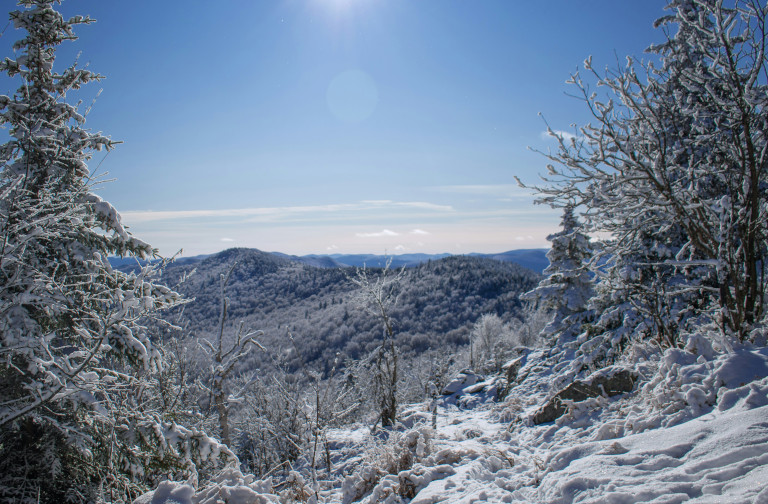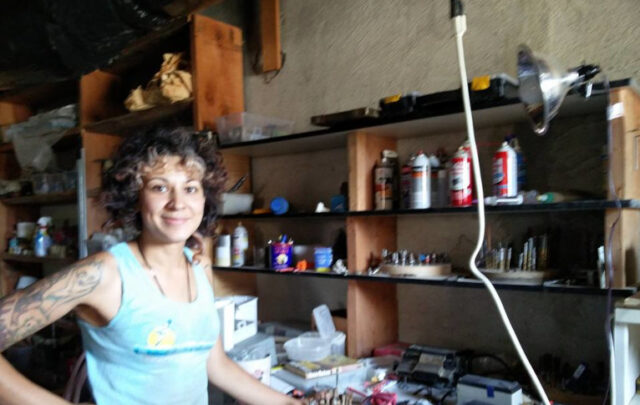The Official Groundhog in Pennsylvania did not see his shadow. If there are groundhogs stirring in Vermont, they also did not see their shadows. There have been few shadows for months and none this week. In my weather calendar, I’ve recorded three days of sun and another four of partial sun since November. Not especially good weather for making shadows.
This is also not especially good weather for making solar energy. These people, who I trust more than most to deliver unbiased information, say that you can expect your solar panel output on fully cloudy days to be just 10-25% of normal. Perhaps, if you have dozens of panels, most of which are just there for redundancy (ie those cloudy days), you may be able to keep the electricity flowing in average Vermont weather. If your solar cell surface area is closer to an average rooftop or free-standing mount, I wonder if you’d even be able to keep the lights lit on cloudy days.
As an example, there is a speed check sign coming into my town’s downtown area where the speed limit drops to 25mph. It is powered by a solar panel that is in full sunshine all day at a good southern exposure angle. The panel has to power a radar gun to record speed and an LED display, so it’s not a great deal of energy use, maybe about the same as a strong incandescent flashlight. I would estimate that the solar panel is about two square feet of surface area. Now, it can get covered in snow on occasion, and there have been a few such snowy days this winter. However, the bigger problem is that there has not been sun. I have not seen that sign lit up since sometime last autumn. This suggests that a fully exposed 2ft square panel can’t keep the lights on in Vermont these days, never mind powering more energy-intensive appliances and tools.
I don’t want to be a solar pessimist. However, I have to be a realist, especially when investing that much in an energy system. You would need to install a large bank of solar panels just to run the lights and perhaps the fridge, an electric range and a hot water heater. But then here in Vermont with all its cloudy days, you would need 4-10 times the surface area necessary for the same output as on a sunny day. So if your energy needs translate into the sunny day capacity of an area of 225 square feet (which is a low average for the energy needs of an average American home), then you need 900-2250 square feet to collect enough photons on cloudy days. At the upper end, that’s about a quarter of my quarter acre property covered in solar panels. And unless I have a similarly large battery bank, I’ll only be able to power things during daylight hours.
I’m not sure that I would make that investment even if I could afford it or had the space for it — neither of which is true. The upper end of that area is more space than my entire rooftop, nearly half of which does not face the sun, ever. I could cut down all the trees in my jungle and put a bank of mounted solar panels out there — and I have thought about doing just that — but then I don’t get to have trees, which would be a much more productive use of that space for a much longer time period than a solar array with a usable life of less than three decades. (Great for me, but only for me… after which that is a large bank of rather toxic trash.) And as for the expense… I used this page of decidedly intimidating numbers to calculate the lowest expense — that is, for 900 square feet, without considering the battery bank — and found that it would cost between $3600 and $9000 just for the panels, no installation labor or mounting equipment or whatever it needs to deliver that energy to your house (which, if it’s going to be a free-standing panel bank out in my jungle, is at least power cabling under or over the street and a substantial upgrade to my house wiring). I don’t have that money. I don’t even know that many people who do, and I am part of a rather affluent demographic.
Of course, most people don’t buy their solar panels. I suspect that the panels in my neighborhood — of which there are very few — are all owned by SunCommon or other solar power companies and are rented by the homeowners. In theory, this rental fee is offset by reduction in electrical energy costs, potentially even credits from Green Mountain Power if the panels are feeding unused energy into the grid. (At times when the grid needs it, that is). However, there are no arrays anywhere in my town that are large enough to be producing sufficient household energy in cloudy weather. So these houses still must be connected to the energy grid and its monthly expense. And I suspect the rent on the panels is more than what is shaved off the grid electricity bill. Especially if the electrical system is providing home heating.
If the house electrical needs include heat, you must have electricity flowing at all times, most especially when there isn’t much, or any, sunlight. I would guess that a well-insulated Vermont tiny house might be heated by a solar-powered heat exchanger if there is a large battery bank somewhere near the tiny house to keep the heat on at night. I doubt it’s even possible to heat my house that way. For one thing, I would need to re-plumb the basement in order for an exchanger to be used in place of my oil-burning furnace. I’m also not clear on whether it’s possible to use my current central air duct system or whether I’d need to install water-based heat delivery — ie radiators and all that incumbent plumbing. If I skipped that and just used a space heating arrangement, I’d need at least one heat pump for each level of my home and probably more than one for the second level, where there are bedrooms and bathrooms. That’s a lot of electricity, and it’s most needed when there is no sunlight.
That’s also a lot of expense. Each space-heating heat pump is going to cost at least $1000 and will need considerable labor and materials to install. There will probably be holes cut in exterior walls. Architectural Digest says that it’s more expensive to install space heating than central heating, though I get the feeling that they are assuming a compatible heat-delivery system is in place. If you need to add ducts or pipes, they seem to think you might as well build a new home. Which few of us can afford.
The other day, I saw a newsletter from 350Vermont that talked about a neighborhood solar grid. For about ten seconds my brain was hijacked by Bright-Shiny-“I want that!” — and then reality reasserted itself. In my neighborhood, the only available space for a community solar panel array is my jungle. I would be happy to cut down the trees in order to power my whole neighborhood, only I don’t know that my quarter acre could power the whole neighborhood. Maybe the lights and minimal refrigeration… if we had more sunshine… From the calculations above, it seems like it would take much of the quarter acre just to power this house if heating is included and the skies remain cloudy.
However, there are also economic problems. For one thing, many of my neighbors live in rental homes. And nobody up here has a great deal of expendable income. In the twenty or so houses nearest my quarter acre, I think less than half are owned and maybe three or four of those homeowners are not on fixed incomes. Renters can do nothing about the electrical systems in their homes even where they have the money to spend (and at current rents, they probably don’t have the money to spend). On the other hand, unless they’re both wealthy and unusually altruistic, older people are rather unlikely to invest their retirement funds in expensive home upgrades — and the majority of property owners, for both home ownership and rental properties, are older. (Remember: Boomers own 53% of all material wealth in this country.)
To get the people in my neighborhood to invest in a communal solar array, I would need to first find the owners of each of these rentals and then convince all those people to spend money that does not benefit them. In fact, it reduces their income. Then I would need to convince the older home-owners to spend money they probably don’t have on an electrical system that they probably won’t use for more than a decade. In summary, in my immediate neighborhood, there might be one or two households who would stand to gain from a neighborhood solar array and could afford to invest in it — however, these are probably the one or two houses that already have rooftop solar.
And none of this addresses the biggest uses of household energy — heat. I would be shocked if a rental property owner would gut their heating systems in order to install electric heat. But I don’t even think it’s possible. To heat twenty old Victorian homes in central Vermont would likely take more solar panels than would fit in all the area taken up by twenty old Victorian homes. It takes a lot of energy to generate the waste heat necessary to warm a house even just a few degrees above ambient temperature. Heck, it takes a lot of energy to generate heat at all — and the more heat needed, the less it is possible for electricity to generate it.
I’m sure you’re aware that most high-temperature industrial processes are just not possible with electrical heat generation. Electrical systems melt down at temperatures far below what is necessary to produce glass, for example. But even within the range of possibility, electrical heat generation is energetically and economically expensive — it takes a lot of pricey electricity to run a heat pump. An average 15 square foot solar panel produces 1.5 kilowatt-hours of energy each day. An average heat pump uses 15 kilowatt-hours every day. That’s ten solar panels just to run the electric heat pump on an average house — and that’s in an average winter climate (whatever that means…). How do you heat Vermont houses with heat pumps? I think for most houses, it may only be possible with grid power — and a considerable investment in electrical upgrades.
In Vermont, this means that electrical heat is largely produced by burning the same fossil fuels that currently heat homes. Perhaps there is less diesel oil in the grid electricity (maybe), but there is very little “renewable” grid electricity. Because the grid is neither publicly nor individually owned, there are few paths to grid-scale fossil-fuel independence. The grid is not a state-owned thing where upgrades can be financed with public money (if there is that much public money). It is not a personally-owned thing that can be financed with property-owner money (again, where there is that money). For most of this country and nearly all of Vermont, grid electricity is a corporation-owned thing that must generate more revenue than expense for its shareholders.
So for as long as it is possible to run power generators with fossil fuels, that is what will happen. There will be no investment in other energy sources. There is no incentive to spend money to create new systems and infrastructure. (Especially when the energy source is inferior to the current system.) But it might not even be economically possible, even if the energy corporation does what corporations do — pass all costs onto their customers. To build out this grid conversion to renewables, users would need to pay many, many times what they currently pay in electrical bills, and most people just don’t have that elasticity in income. Money doesn’t appear just because expenses are increasing. There would, instead, be a large-scale reduction in electrical energy use as more and more people were unable to pay those costs. Which demand-destruction would result in a collapse of the grid.
So unless we start converting our energy systems to user-owned corporate entities that do not need to produce profit — just energy — it is very unlikely that grid-scale energy will be converted to anything other than what it runs on now. But even if we do that impossible thing, the conversion will still cost money. Who will pay for this transition and with what? Who or what is going to pay for the labor, resources, and energy needed to do all this? Do we nationalize every part of the process — from mining and manufacturing and installation to disposal of the current infrastructure? Do we nationalize all resources? And still, how is it paid for even then? Who or what is going to pay taxes that can be spent on nationalized expenses? And once we jump that considerable hurdle, who or what is going to pay for maintaining this whole edifice? I just don’t see how this is going to happen… This energy grid conversion would cost more than we have to spend. And the conversion is just the beginning of the expenditure.
And this brings me to the most intractable problem with running the house on solar energy. Or renewables generally. This wholesale conversion is not a one-time expense. Renewables are not really renewable. Yes, the energy source is more or less continually available (though rather intermittent in Vermont weather). But none of the tools that we currently use to harvest that energy are renewable, and none of them last for more than a few decades. This whole infrastructure would need to be replaced at least every generation. All the solar panels. All the electrical infrastructure. All the turbines and generators. And because almost none of it can be recycled, nearly all of it is waste, a good deal of which is highly toxic. Where does all that waste go? Where do the new resources come from? How do we generate the heat necessary to make these tools? Glass panels, steel, concrete footings — all of these processes require temperatures that can’t be generated with electricity. And most problematically, how do we move all this bulky stuff around without fossil-fueled engines?
If we pooled all our labor and resources together to turn everything over to renewable energy right now — if that were possible! — we would only have about three decades of energy use, after which… we’d have what we could produce locally, at human scale… and a large pile of toxic trash everywhere.
And even if that miraculous conversion could be accomplished, there’s still no guarantee that, in that very short term of system viability, Vermont would have heat in cloudy winter weather. Among other issues… (For example, did you know that solar panel output is also substantially reduced at air temperatures above 77°F? I didn’t until today… puts air conditioning in a whole new light…)
This does not seem like a reasonable project, even to gain a bridge to a more sustainable way of living. It sounds like it costs more than the Earth has. And what exactly does it buy us?
It seems to me that the only thing it gains is the ability to use electrical appliances for a few more decades. Probably only for a few wealthy people. And only if we keep using fossil fuels for mining, transport, and manufacturing everything.
So what if we don’t do that? What if we transition instead to the long-term, localized, human-scale economy that is inevitable no matter what we do? What does that look like?
There may still be solar panels. However, I suspect most will be for heating, not generating electricity. Most of our actual energy needs relate to heat, and electricity is approximately the worst method of producing heat. Moreover, unlike a solar electricity panel, a solar heating panel is made up of simple components that can largely be made at human scale, using local resources. Glass is still a problem, but maybe we’ll come up with ways to create translucent panes of wax or fabric or bioplastics that can withstand weather. And for the interim, we have glass — and glass itself is rather durable and recyclable and non-toxic. In any case, at small scales, it might be possible to repair solar heat panels more or less indefinitely. This still requires a considerable expense in heating infrastructure replacement, but given that Roman plumbing still works, I suspect that we wouldn’t need to replace that infrastructure more than once, certainly not every generation.
And maybe we reconsider home heating. Maybe we don’t heat a whole building, but only the parts that need to be heated, the places we sit and sleep and have pipes that must be kept above freeing. Maybe we don’t heat spaces forty to fifty degrees above ambient temperature. Maybe we wear more clothing and use blankets in winter. Maybe we don’t have enormous rooms and high ceilings and lavish panes of glass letting in the light — while just as effectively letting out the heat. And maybe we start to rebuild our homes to take advantage of ground warmth — and cooling!
There will also be heat needed for cooking and cleaning — because there has always been heat needed for those tasks, as long as we’ve been human. There will be burning, but I suspect we’ll go back to burning wood and peat and animal wastes in small, contained fires. We probably won’t be as profligate with our cooking as we are today, but then we probably won’t have as much desire to be profligate. When cooking is about filling bellies and nurturing bodies, there really isn’t much energy necessary. One loaf of bread and a pot of stewed veg can amply feed a body for a week. This is a matter of a few hours of fire, maybe a dozen in a month, the equivalent of maybe three or four foot-long sections of quartered maple limb. And of course, when there is fire for cooking, there is also space heating. The wood-fired stove can bake the bread and — when paired with thermal mass like iron and masonry — heat the entire room for hours.
I suspect this is where we are going no matter what sort of transition we think we are creating. We just don’t have the resources to invest in short-term systems. We don’t have the resources for much of anything really. Whatever comes next will be a cobbling together of what exists now, and acres of solar panels along with all their incumbent electronic infrastructure do not now exist. Nor does any electronic thing that will last more than a few years. And as those electronic things wear out it will be increasingly impossible to replace them. Within a couple decades, an electrical grid will not be necessary because we won’t have the functioning stuff left to consume electrical energy at grid-scale.
So, what will happen in cloudy weather in Vermont? For one thing, we’ll all be sleeping more, and we won’t be doing much when we are awake. We won’t be going shopping or otherwise traveling around. We won’t be engaging in the immense waste of resources and time that is wage work. We will probably be hunkered down with small tasks, few of which require more-than-human energy. As this century wears on, we’ll be repurposing whatever we have into whatever we need. There will be less need of large heated buildings, more need of space for trees and other truly renewable fuels, those that can reproduce themselves. My quarter acre jungle planted in fruit and nut and maple trees will be an invaluable store of real, warm wealth!
And when the sun doesn’t shine, we’ll gather around the wood stove. It will not always be pleasant, but then it’s not pleasant today either for most people. And a world covered in toxic trash, the energy fever dreams of today’s wealthy people, would be thousands of times worse. Probably unsurvivable… So I’ll take the quickest path out of today’s energy-sucking culture. And that path does not include photovoltaic heat.
I suspect the Official Groundhog will be predicting earlier and earlier springs. The real groundhogs will be sleeping until spring actually arrives, when the green world awakens, which is a function of sunlight as much as weather. The irony is that even though it will be warmer and the Groundhog won’t be seeing his shadow for all the clouds, plants will not be putting out growth any earlier because they won’t have enough light to feed themselves. It may be spring warmth, but it won’t be spring until we get some sun.
Similarly, winter may be warmer, but it won’t be warm enough to go without heat — and heat will be very difficult to generate from sunlight in cloudy, short winter days. Among the many flaws in depending on technology to save us, this is one of the most fatal. If we put all our efforts into creating a system of electric heat, what we’re going to produce is very little warmth for most people, a whole lot of wasted resources and toxic trash — and no capacity to produce any energy at all within a few decades.
Perhaps we need to take a lesson from real groundhogs… sleep through the dark winter… until there is enough sunlight for shadows. And use the Earth’s natural capacities to keep you warm.





